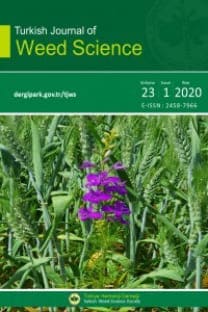İstilacı Yabancı Ot Galinsoga ciliata (Raf.) S.F. Blak'in Bozdağ Sebze Alanlarındaki Değişimi
2013 ve 2014 yıllarında, İzmir İli Bozdağ İlçesi Gündoğan mevkiinde yapılan survey çalışmasında, Compositae familyasından Galinsoga ciliata (Raf.) S.F. Blake yabancı ot türünün yoğunluğu belirlenmiştir. 2000 dekar alana sahip sözkonusu yörede yaklaşık 500 dekarlık alanında G. ciliata'nın büyük problem olduğu, yabancı otun hızlı bir şekilde yayıldığı ve yoğunluğunun arttığı, hatta Gündalan ve Çavdar yaylalarına kadar bulaştığı, diğer yabancı ot türlerini baskı altına aldığı görülmüştür. Söz konusu türün, yörede yoğun üretimleri yapılan patates, lahana, karnabahar, brokoli, marul ve fasulye tarlalarının tümünde, kültür bitkisi farkı oluşturmaksızın sorun oluşturduğu gözlenmiştir. Patates, lahana, karnabahar, brokoli, marul ve fasulye tarlalarında 1 m2 ’lik alanlarda yapılan sayımlarda: 2013 yılında, Lahanada ortalama 215,2; Fasulyede ortalama 184,8; Marulda, Iceberg çeşidinde ortalama 126; Kıvırcık çeşidinde 129,7; Brokolide ortalama 47,14; Patateste ortalama 91,5 adet söz konusu yabancı ot türünün bulunduğu; 2014 yılında ise, Karnabaharda ortalama 100; Lahanada ortalama 172,2; Fasulyede ortalama 118,4; Marulda, Iceberg çeşidinde ortalama 136,1; Kıvırcık çeşidinde 88,2; Brokolide ortalama 45,8; Patateste ortalama 89,9 adet G. ciliata tespit edilmiştir. 2014 bitkinin yoğunluğunda azalma görülürken sirken, darıcan, horozibiği, kuş otu, darıcan gibi yabancı ot türlerinin arttığı gözlenmiştir. Üreticilerden; caramba yem bitkisi ile buğdayın karışım ekilmesinin G. ciliata popülasyonunu azalmasında etkili olduğu bilgisi alınmıştır. Tek yıllık, otsu bir bitki olan G. ciliata çok sayıda tohum oluşturabilmesi ve tohumlarının rüzgarla kolaylıkla taşınabilir yapıda olması yayılmasını kolaylaştırmaktadır. Ayrıca bitkinin toprağa değen kısımlarından kökler oluşturabilmesi yoğunluğunu daha da artırmakta, kısa sürede istilacı konumuna gelebilmektedir. Diğer yabancı otlar gibi kültür bitkileri ile rekabet oluşturarak verim ve kaliteyi etkileyen G. ciliata ile mücadelede öncelikle bulaşmayı önleyici kültürel önlemlerinin alınmasına gerekmektedir. Bunun için; kullanılan tohumluk ve fidelerin yabancı ot tohumundan ari olmalı, çiftlik gübreleri iyi fermente edilerek kullanılmalı, toprak işlemede kullanılan alet ve ekipmanın temizliğine dikkat edilmeli, yabancı ot tohumları sulama suyu ile bir tarladan diğerine taşınması engellenmelidir. Elle yolma, çapalama gibi mekanik mücadele yapılmalı, yabancı otlar tohum bağlamadan önce mutlaka biçilerek veya çapalanarak tarladan uzaklaştırılmalıdır.
THE OCCURRENCE OF INVASIVE WEED GALINSOGA CILIATA (RAF.) S.F.
BLAKE IN VEGETABLE AREAS OF BOZDAG DISTRICT (IZMİR, TURKEY)
In survey studies carried out in 2013 and 2014, in Izmir Province Bozdag County Gundogan province the occurrence and density of Galinsoga ciliata (Raf.) S.F. Blake (Compositae) was determined. During the surveys it was determined that the above mentioned weed has become a serious problem in about 50 hectares of the total 200 hectares of the province and it has been seen that it was spreading quickly and already infected parts of Gundalan and Cavdar springs, with its ability to suppress the other weed species it has become a major problem in the main potatoes, cabbage, cauliflower, broccoli, lettuce and beans fields. Measurements carried out in 1m2 areas in potatoes, cabbage, cauliflower, broccoli, lettuce and bean plantations, at 2013, showed average of 215.2 in sprouts, 184.8 in beans, 126 in lettuce, 129.7 in kinds of curly, 47.14 in broccoli and 91.5 presence of the above mentioned weed species. At 2014, showed average of 100 in cauliflowers, 219,8 in cabbage, 118,4 in beans, 132,9 in lettuce , 136,1 in kinds of curly,88,2, 45,8 in broccoliand89,9 in potatoes presence of the abovementioned weed species. G. ciliata density reduction observed in 2014, it was observed that an increase in weed species such as green pigweed, red root pigweed, barnyard grass, chick weed. Caramba fodder from producers of wheat with a mixture of information that has been effective in reducing the G.ciliata the cultivated populations. Being an annual, herbaceous plant G. ciliata can create many seeds. Seeds are portable structure which further facilitates their spread by the wind. Also forming of plant roots by the parts of plant that has contact with the soil further increases their density, as a result, invades locations. G. ciliata which like other weed species, creating competes with crop plants primarily control measurements for this weed species includes cultural methods aiming prevention of contamination. For this reason the seed material and seedlings must be weed seed free, the farm manure used must be well fermented, the soil treatment equipment must be clean and also the transport of weed material from field to filed by irrigation water must be controlled. Mechanical control such as hand-pulling and hoeing and removing of weeds from fields before seed dispersal by cutting or hoeing must be implemented.
